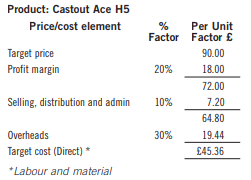July 2021
Philip Dunn explains everything you need to know about this important technique.
Those preparing for CIMA P1 and ACCA PM need to be fully aware of target costing and the way in which it adds value to the understanding of the factors that drive cost and price in a competitive environment.
Much literature cites Japanese companies developing and using target costing; Toyota, Honda and Nissan are such examples. In the US, Caterpillar and Chrysler are examples where economic benefits of the technique have been noteworthy.
Traditional pricing and costing
Full cost pricing has been the model used by many businesses in the past. Standards and standard costing technique was used to determine a product’s cost of labour and material, overhead was absorbed, a share of selling distribution and administration cost was added to achieve a product’s total cost. Price was then set by adding a desired profit margin.
This additive model worked well and was appropriate when markets were not as efficient and responsive as they are today.
If the price was acceptable in the market it was only experienced when the product was actually introduced to potential customers. This could result in the price being either too high or too low and therefore a technique was developed that prevents pricing error and aids faster, more focused product development.
Target Costing
“Target costing describes a process of first assessing a target price and then designing a product to meet this price” (Hergeth).
It is part of a total cost management system which deviates from traditional accounting to managerial accounting and moves decision making from an accountant’s perspective to the marketplace.
It is a top down process:
• Setting price.
• Setting profit.
• Setting cost.
The process is interactive and comprises three phases: market level, product level and component level (Cooper and Slagmulder 1999):


Target costing therefore builds upon a design to cost approach, where the focus is a market-driven price as a basis for establishing target costs.
Hergeth in his research states: “The key element in target costing is the market orientation of the entire costing and product development process. By introducing the market price as the focal point of the analysis, target costing avoids problems of other costing approaches:
• Costing becomes a managerial tool to achieve successful product design rather than documenting historical data.
• An economically relevant variable (price) becomes the driver of the product development process rather than its output.
This results in a market and profit driven product development process.
• Due to its market orientation target costing can consider long-term corporate strategies in the market. Variable costing and activity based costing tend to focus more on short-term goals.
• Due to its specific purpose target costing tends to provide decision relevant data, while traditional absorption costing models tend to document all cost, independent of the decision making relevance.”
Castout case study
Castout is an SME that manufactures sea fishing rods. The company operates target costing methodology.
They would need to compare the original estimated cost of a product to target cost.
If this was greater than target we would need to reconsider design and possibly reduce associated expenses or examine our decision to offer the product.
This could involve re-examining processes to introduce cost reducing efficiencies.
Target Cost Profile

The target cost of the product (Direct Costs) is £45.36 and therefore that is the benchmark set for this activity.
The target costing process integrates many activities and tasks. The target costing team needs to be drawn from disciplines within the company to include finance, manufacturing, purchasing and marketing.
We need, as with our budgetary control mechanism, a participative approach to target cost management.
Conclusion
Although the technique in its simplest form is merely a model – target price minus profit margin = target cost, today’s highly competitive marketplace and external environment can make the technique a strategic management tool.
It can be incorporated into our management accounting portfolio and provide the company with economic value added and strategic benefit. It will allow us to focus on the use of limited resources to maximise opportunity to achieve target return on investment.
• Readers are also referred to ‘A Practical Guide to Target Costing’ by Frank Robinson (a CIMA publication).
• Dr Philip E Dunn is a freelance author and technical editor for Kaplan and Osborne Books




